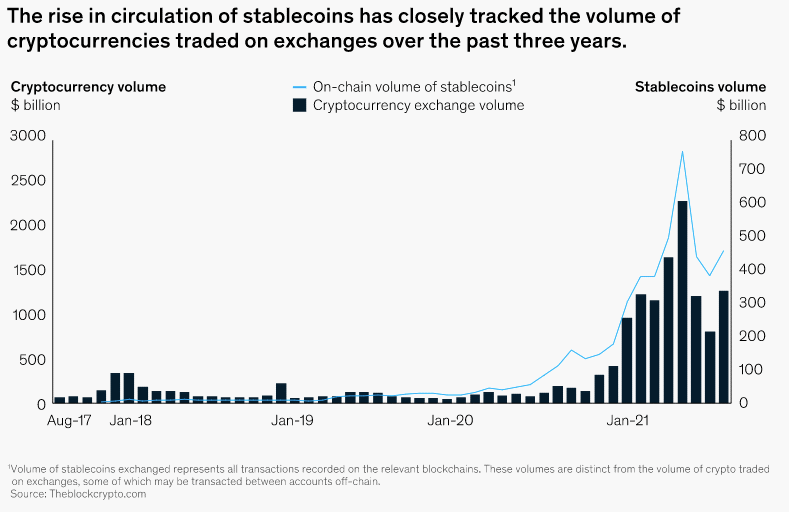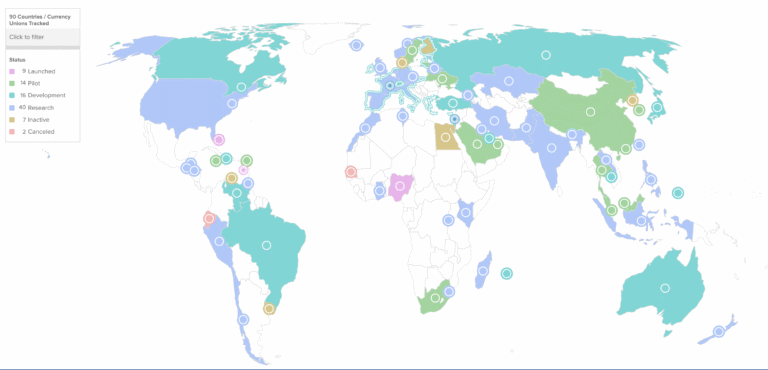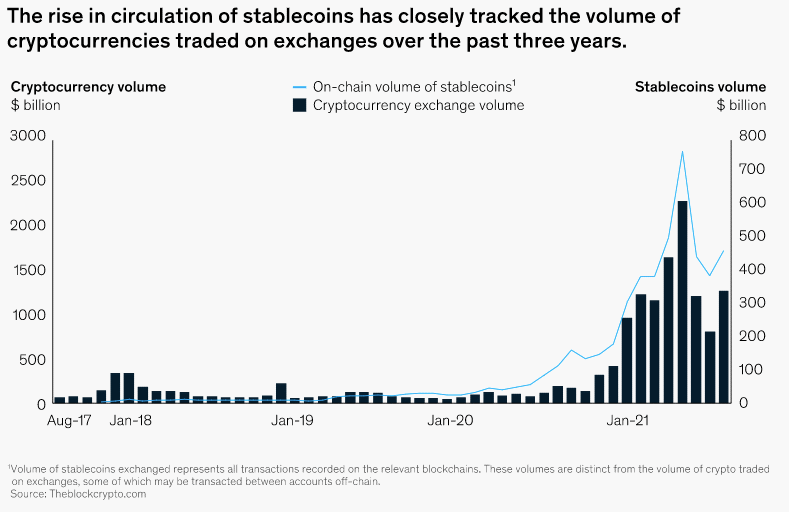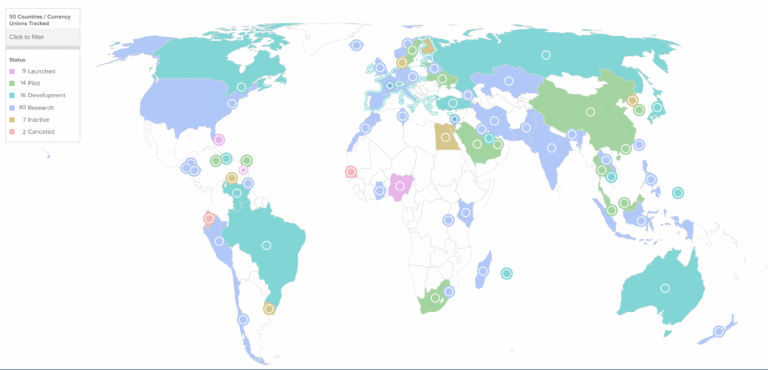IMAGE SOURCE
Digitalization is affecting everything and is accelerated by the pandemic. One area unable to escape this accelerated trend is money. Money inventions have challenged and transformed the structure of the financial system throughout history. Time and again, innovations have sparked disputes about the dangers they represent and the benefits they provide, as well as the role of central banks in fostering financial trust. Not so long ago, cash was more or less the only way to make an immediate purchase. However, we have grown accustomed to using forms of private digital money such as online bank transfers, debit cards, and applications on our smartphones or smartwatches. As a fellow of the Digital Euro Association, a think tank specializing in crypto assets, stablecoins and central bank digital currencies (CBDC), we are working on contributing to the public and political discussion between policy-makers, technologists, and economists.
The rise of cryptocurrencies and stablecoins, like Facebook’s Diem (formerly Libra), is forcing governments to rethink national digital currencies. Central banks want to maintain control over money, but the meteoric rise of cryptocurrencies has clearly shown that people no longer trust their national currencies, such as Venezuelans and Nigerians, and want to control their money.
Digitalization is affecting everything and is accelerated by the pandemic. One area unable to escape this accelerated trend is money. Money inventions have challenged and transformed the structure of the financial system throughout history. Time and again, innovations have sparked disputes about the dangers they represent and the benefits they provide, as well as the role of central banks in fostering financial trust. Not so long ago, cash was more or less the only way to make an immediate purchase. However, we have grown accustomed to using forms of private digital money such as online bank transfers, debit cards, and applications on our smartphones or smartwatches. As a fellow of the Digital Euro Association, a think tank specializing in crypto assets, stablecoins and central bank digital currencies (CBDC), we are working on contributing to the public and political discussion between policy-makers, technologists, and economists.
The rise of cryptocurrencies and stablecoins, like Facebook’s Diem (formerly Libra), is forcing governments to rethink national digital currencies. Central banks want to maintain control over money, but the meteoric rise of cryptocurrencies has clearly shown that people no longer trust their national currencies, such as Venezuelans and Nigerians, and want to control their money.

At an international level, the digitalization of money and payments is being examined by the G7 and the G20. In Europe, it is frequently discussed by Finance Ministers in the Eurogroup.
Some fear that digitalization, if not properly governed could create instability and even threaten the monetary system. Central banks are considering whether they should innovate by offering digital money. Unlike bitcoin and other cryptocurrencies, central bank digital currencies (CBDC) are government-issued, basically digital versions of existing national currencies.
Race for the future of money
Over the past two years, central banks around the world have been working on CBDCs. A survey in 2020 showed that 86% of all central banks are conducting research on CBDCs. The Atlantic Council, a nonpartisan global leadership organization, released a six-month update of its central bank digital currency tracker on December 13th. Today, 87 countries (representing over 90 percent of global GDP) are exploring a CBDC, 9 countries have now fully launched a digital currency and 14 countries, including China and South Korea, are now in the pilot stage with their CBDCs and preparing a possible full launch.
Some fear that digitalization, if not properly governed could create instability and even threaten the monetary system. Central banks are considering whether they should innovate by offering digital money. Unlike bitcoin and other cryptocurrencies, central bank digital currencies (CBDC) are government-issued, basically digital versions of existing national currencies.
Race for the future of money
Over the past two years, central banks around the world have been working on CBDCs. A survey in 2020 showed that 86% of all central banks are conducting research on CBDCs. The Atlantic Council, a nonpartisan global leadership organization, released a six-month update of its central bank digital currency tracker on December 13th. Today, 87 countries (representing over 90 percent of global GDP) are exploring a CBDC, 9 countries have now fully launched a digital currency and 14 countries, including China and South Korea, are now in the pilot stage with their CBDCs and preparing a possible full launch.

Sources: Atlantic Council Research, Bank of International Settlements, International Monetary Fund, John Kiff Database
China has been experimenting with the digital yuan since 2014. The digital yuan has already been used to process over $5 billion in transactions. Sweden recently launched a pilot of the e-Krona with a small number of real-life market participants. The “sand dollar,” in the Bahamas, is already in operation used as a means of payment. Nigeria is the latest country to launch a CBDC, the e-Naira.
Out of the big four central banks, including those of the EU, UK, and Japan, only the US has not progressed beyond research mode in central bank digital currencies. The Federal Reserve Board (FRB) released a whitepaper in January 2022, that looks into the pros and cons of creating a central bank digital currency for the United States.
The United Arab Emirates and Saudi Arabia launched a bilateral CBDC pilot project called Project Aber in 2019, and concluded that DLT can successfully facilitate cross-border transactions. In February 2021, the United Arab Emirates joined China, Hong Kong, and Thailand in a joint CBDC cross-border test. This “Multiple Central Bank Digital Currency (m-CBDC) Bridge” will test the use of DLT for foreign currency payments. The latest cross-border payment test is Project Dunbar – a partnership between South Africa, Singapore, Malaysia, and Australia.
Some countries are taking a completely different approach. In the fall, El Salvador became the first nation in the world to adopt bitcoin as a national currency. El Salvador’s citizens can use bitcoin to pay any business for its products and services.
Two or three years ago, few were talking about the digital euro. Now the European Central Bank (ECB) is planning to unveil the digital euro in the next five years. The rise of stablecoins to over $120 billion combined with the expansion of big tech companies into finance has brought the digital euro to the foreground.
European Central Bank
In October the ECB started an investigation phase for the possible introduction of a digital euro. The digital euro would still be a euro, only in digital form. Unlike cash, the digital euro will be used digitally and in a programmable way, but payments with a digital euro will not be as anonymous as a payment in cash.
The digital euro will be an attractive alternative to cash. It will function as a crypto asset that can be integrated into fully automated transactions, without the need for any human intervention. According to estimates, the internet of things will connect 24 billion devices by 2030, with 23% of the devices in the EU.
From a strategic standpoint, a digital euro accessible to foreign users would cut the cost of using the euros in cross-border payments, increase the international role of the euro, strengthen Europe’s strategic autonomy, and lessen the global domination of the US dollar.
But, issuing a digital euro would affect society as a whole. Complex questions and difficult choices lie ahead about how to introduce the digital euro to the market. The right balance needs to be struck to make the digital euro robust and easy to operate.
In a truly digitalized economy, CBDCs are a natural next step. The financial infrastructure in any given country will play a key role in the speed and extent of adoption of CBDCs, stablecoins, or cryptocurrencies. The development of CBDCs is a response to the challenge cryptocurrencies and private stablecoins pose to the central banks. Digital national digital currencies like the digital euro are a positive step in our digital evolution, as we transition from fiat to sound money (that is not prone to sudden appreciation or depreciation in purchasing power over the long term), like bitcoin. While it is too early to predict what will happen and what shape money in the future will take, in the end, people will decide whether to use cryptocurrencies or CBDCs.
China has been experimenting with the digital yuan since 2014. The digital yuan has already been used to process over $5 billion in transactions. Sweden recently launched a pilot of the e-Krona with a small number of real-life market participants. The “sand dollar,” in the Bahamas, is already in operation used as a means of payment. Nigeria is the latest country to launch a CBDC, the e-Naira.
Out of the big four central banks, including those of the EU, UK, and Japan, only the US has not progressed beyond research mode in central bank digital currencies. The Federal Reserve Board (FRB) released a whitepaper in January 2022, that looks into the pros and cons of creating a central bank digital currency for the United States.
The United Arab Emirates and Saudi Arabia launched a bilateral CBDC pilot project called Project Aber in 2019, and concluded that DLT can successfully facilitate cross-border transactions. In February 2021, the United Arab Emirates joined China, Hong Kong, and Thailand in a joint CBDC cross-border test. This “Multiple Central Bank Digital Currency (m-CBDC) Bridge” will test the use of DLT for foreign currency payments. The latest cross-border payment test is Project Dunbar – a partnership between South Africa, Singapore, Malaysia, and Australia.
Some countries are taking a completely different approach. In the fall, El Salvador became the first nation in the world to adopt bitcoin as a national currency. El Salvador’s citizens can use bitcoin to pay any business for its products and services.
Two or three years ago, few were talking about the digital euro. Now the European Central Bank (ECB) is planning to unveil the digital euro in the next five years. The rise of stablecoins to over $120 billion combined with the expansion of big tech companies into finance has brought the digital euro to the foreground.
European Central Bank
In October the ECB started an investigation phase for the possible introduction of a digital euro. The digital euro would still be a euro, only in digital form. Unlike cash, the digital euro will be used digitally and in a programmable way, but payments with a digital euro will not be as anonymous as a payment in cash.
The digital euro will be an attractive alternative to cash. It will function as a crypto asset that can be integrated into fully automated transactions, without the need for any human intervention. According to estimates, the internet of things will connect 24 billion devices by 2030, with 23% of the devices in the EU.
From a strategic standpoint, a digital euro accessible to foreign users would cut the cost of using the euros in cross-border payments, increase the international role of the euro, strengthen Europe’s strategic autonomy, and lessen the global domination of the US dollar.
But, issuing a digital euro would affect society as a whole. Complex questions and difficult choices lie ahead about how to introduce the digital euro to the market. The right balance needs to be struck to make the digital euro robust and easy to operate.
In a truly digitalized economy, CBDCs are a natural next step. The financial infrastructure in any given country will play a key role in the speed and extent of adoption of CBDCs, stablecoins, or cryptocurrencies. The development of CBDCs is a response to the challenge cryptocurrencies and private stablecoins pose to the central banks. Digital national digital currencies like the digital euro are a positive step in our digital evolution, as we transition from fiat to sound money (that is not prone to sudden appreciation or depreciation in purchasing power over the long term), like bitcoin. While it is too early to predict what will happen and what shape money in the future will take, in the end, people will decide whether to use cryptocurrencies or CBDCs.

Ilias Louis Hatzis
Ilias Louis Hatzis is the Founder & CEO at Mercato Blockchain Corporation AG.
Ilias Louis Hatzis is the founder and CEO at Kryptonio wallet. Create your wallet in less than a minute, without seed phrases, private keys, passwords or documents. Keep your bitcoin and digital assets always secure and recoverable: https://kryptonio.com
I have no positions or commercial relationships with the companies or people mentioned. I am not receiving compensation for this post.
Ilias Louis Hatzis is the founder and CEO at Kryptonio wallet. Create your wallet in less than a minute, without seed phrases, private keys, passwords or documents. Keep your bitcoin and digital assets always secure and recoverable: https://kryptonio.com
I have no positions or commercial relationships with the companies or people mentioned. I am not receiving compensation for this post.
Autres articles
-
NFT Factory s'envisage en mode itinérant avant de se ré-ancrer au coeur de la capitale
-
La startup française, Multis s'abrite désormais au sein de l'entreprise suisse, Safe,
-
Lazard x Elaia : c'est signé !
-
Pixpay, les ados et Shein : quand la fintech se penche sur la conscience écolo des ados
-
Nomination | Société Générale annonce l'arrivée d'Antoine Jacquemin au poste de Responsable Mondial de la vente Taux, Change et Placement aux entreprises au sein des Activités de Marché



















